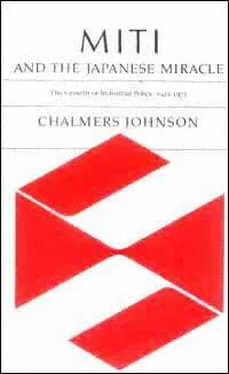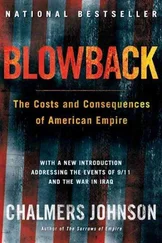Chalmers Johnson - MITI and the Japanese miracle
Здесь есть возможность читать онлайн «Chalmers Johnson - MITI and the Japanese miracle» весь текст электронной книги совершенно бесплатно (целиком полную версию без сокращений). В некоторых случаях можно слушать аудио, скачать через торрент в формате fb2 и присутствует краткое содержание. Год выпуска: 2007, Издательство: Stanford University Press, Жанр: Старинная литература, на английском языке. Описание произведения, (предисловие) а так же отзывы посетителей доступны на портале библиотеки ЛибКат.
- Название:MITI and the Japanese miracle
- Автор:
- Издательство:Stanford University Press
- Жанр:
- Год:2007
- ISBN:нет данных
- Рейтинг книги:3 / 5. Голосов: 1
-
Избранное:Добавить в избранное
- Отзывы:
-
Ваша оценка:
- 60
- 1
- 2
- 3
- 4
- 5
MITI and the Japanese miracle: краткое содержание, описание и аннотация
Предлагаем к чтению аннотацию, описание, краткое содержание или предисловие (зависит от того, что написал сам автор книги «MITI and the Japanese miracle»). Если вы не нашли необходимую информацию о книге — напишите в комментариях, мы постараемся отыскать её.
MITI and the Japanese miracle — читать онлайн бесплатно полную книгу (весь текст) целиком
Ниже представлен текст книги, разбитый по страницам. Система сохранения места последней прочитанной страницы, позволяет с удобством читать онлайн бесплатно книгу «MITI and the Japanese miracle», без необходимости каждый раз заново искать на чём Вы остановились. Поставьте закладку, и сможете в любой момент перейти на страницу, на которой закончили чтение.
Интервал:
Закладка:
Page 173
divorce administration from some of the most obvious features of aggressive imperialism."
27
Since SCAP had decided on an indirect occupation, which left the Japanese government intact even if taking orders from SCAP, the Allies did not demand a reform of all ministries, only those that had been closely connected with the military or the police (one was the Home Ministry), which the occupation ordered abolished. SCAP intended to deal on an individual basis with those bureaucrats whom it held responsible for the warthrough the purge rather than through structural change. But as we saw in Chapter 2, recent Japanese estimates put the number of MCI officials who were actually purged at only 42; and according to SCAP's own figures, it investigated 69 MCI officials but removed from office only 10.
28
Thus Shiina's last-minute ploy worked quite well; the trade and industry bureaucracy maintained its continuity despite the crisis of defeat.
The accounts of what happened during the four years from mid-1945 to mid-1949 in the realm of economic and industrial policywhether by SCAP officials or Japaneseoften differ so markedly as to make it appear that each side is talking about a different country. SCAP began the occupation by declaring that the Japanese had brought about their own economic difficulties and that the Allies therefore took no responsibility for maintaining any particular level of living in Japan. However, the Americans quickly discovered that if they stuck to this positiongiven the collapse of all Japanese international tradethey would merely ensure a communist revolution in Japan and not a "democratically reoriented" country.
29
The Americans therefore began state-controlled trade and demanded that the Japanese government impose economic controls. As it turned out, the prewar and wartime victories of the zaibatsu over the state-control bureaucrats proved to be the zaibatsu's undoing. SCAP declared that the zaibatsu had been responsible for the war economy, banned any further private cartels, and ordered government officials to exercise the powers previously reserved for the control associations. MCI officials of the "Kishi-Shiina line" were only too happy to oblige; after their struggles of the previous fifteen years, it suddenly seemed as if they had arrived in the bureaucratic promised land.
Similarly, with regard to emergency economic rehabilitation measures or positive economic reforms, the Japanese and the Americans often seemed purposely to misunderstand each other. Yoshida Shigeru (18781967), the great ex-bureaucrat prime minister who presided over Japan's rise from the ashes, once commented, "The occupation, with all the power and authority behind its operation, was
Page 174
hampered by its lack of knowledge of the people it had come to govern, and even more so, perhaps, by its generally happy ignorance of the amount of requisite knowledge it lacked.
*
Thus SCAP would sometimes approve of MCI proposals that the Americans thought were temporary expedients but that ended up lasting until well into the 1960's (foreign exchange budgets, for example). As for SCAP's policies calling for zaibatsu dissolution, the officials of MCI's old Enterprises Bureaunow called the Readjustment Department (Seiri Bu)administered this program with enthusiasm. But when it came to economic deconcentration generally, toward which the breakup of the zaibatsu was only a means and not an end, the industrial bureaucrats quickly discovered that there were divisions within SCAP and took advantage of them. Eleanor Hadley, herself a SCAP trustbuster, explains:


Inasmuch as in the United States commercial banks are not permitted to have industrial and trading subsidiaries or affiliates, the American vocabulary and way of thinking is to regard commercial banking as quite separate from industry and commerce. . . . The Economic and Scientific Section of [SCAP] Headquarters . . . was set up with an Antitrust and Cartel Division and a Finance Division, which was a mistake. . . . The result of the actual arrangement was that the Antitrust and Cartel Division claimed jurisdiction in antitrust matters over the banks, but the staff of the Finance Division insisted that the banks were entirely theirs (and their responsibility included no antitrust assignment!).
31
After the occupation the old zaibatsu were recreated on the basis of their banks rather than their former family holding companies. This was a much more rational and effective arrangement, but it is certain that this was not exactly what SCAP had in mind. In fact, in 1975, with no apparent sense of irony, the Japanese government awarded its Second Class Order of the Sacred Treasure to Tristan E. Beplat, who had recently retired as a senior vice-president of the Manufacturers Hanover Trust Company of New York. As the
Japan Times
explained, Beplat was "an American banker who the government said


*
See
The Yoshida Memoirs
, p. 128. However, Yoshida himself was not above attempting to fool SCAP officials. "The original GHQ plan, as handed to us," Yoshida writes, "called for the purging of 'standing directors' as well as others occupying top positions. This was translated into Japanese by our side as 'managing directors.' Strictly speaking, however, a 'standing director' could be interpreted as one who functioned regularly in a company, which would have included most ordinary directors. We held to our interpretation that 'standing directors' were, in fact, managing directors, and by so doing were able to save many ordinary directors who might otherwise have been so classified from the purge. Which shows that upon occasion mistranslations serve their turn."
Ibid.
, pp. 15556. The issue here is the translation of the difficult terms
senmu torishimariyaku
(executive director),
jomu
*
torishimariyaku
(managing director), and
torishimariyaku
(director).
30
Page 175
had made a vital contribution to Japan's postwar economic recovery. . . . He was in charge of occupation policy toward Japanese banking from 1945 to 1948. . . . Many financial leaders, including [then] Deputy Prime Minister Fukuda Takeo, credit him with preventing the breakup of Japanese banks and insurance companies in the postwar dismemberment of zaibatsu companies in Japan.''
32
Without wishing to detract from Beplat's award in any manner, one may suggest that from the Japanese, and especially from MCI's point of view, there was a degree of
menju
*
fukuhai
(following a superior's orders to his face while reversing them in the belly) at work during those immediate postwar years.
Sometimes Japanese officials genuinely did not understand what SCAP wanted them to do. For example, with regard to the Antimonopoly Law (number 54 of April 14, 1947), Morozumi Yoshihiko, who 25 years later became vice-minister of MITI, recalls his painful efforts during the occupation to translate article by article into legal Japanese the draft of the Antimonopoly Law that General MacArthur's headquarters had sent over to MCI for enactment. "It seems laughable today," he writes, "but then we didn't really know what they were talking about."
33
When Morozumi showed his draft to his "senior," Murase Naokai, then chief of the Cabinet Legislation Bureau, Murase asked him what something he had translated meant and he was forced, much to his embarrassment, to reply that he did not know. Murase got the drift of the law only by looking at the original English text. Needless to say, the Antimonopoly Law was not something the Japanese were able to avoid or evade. As we shall see in the next two chapters, MITI spent the succeeding 30 years struggling to get around Morozumi's handiwork. The tension that developed between MITI on the one hand and the Fair Trade Commission (created by the law) on the other undoubtedly made a contribution to the favorable climate in which high-speed growth took place. This tension, unintended by either SCAP or MCI, may have been one of the occupation's greatest contributions to the economic "miracle."
Читать дальшеИнтервал:
Закладка:
Похожие книги на «MITI and the Japanese miracle»
Представляем Вашему вниманию похожие книги на «MITI and the Japanese miracle» списком для выбора. Мы отобрали схожую по названию и смыслу литературу в надежде предоставить читателям больше вариантов отыскать новые, интересные, ещё непрочитанные произведения.
Обсуждение, отзывы о книге «MITI and the Japanese miracle» и просто собственные мнения читателей. Оставьте ваши комментарии, напишите, что Вы думаете о произведении, его смысле или главных героях. Укажите что конкретно понравилось, а что нет, и почему Вы так считаете.












